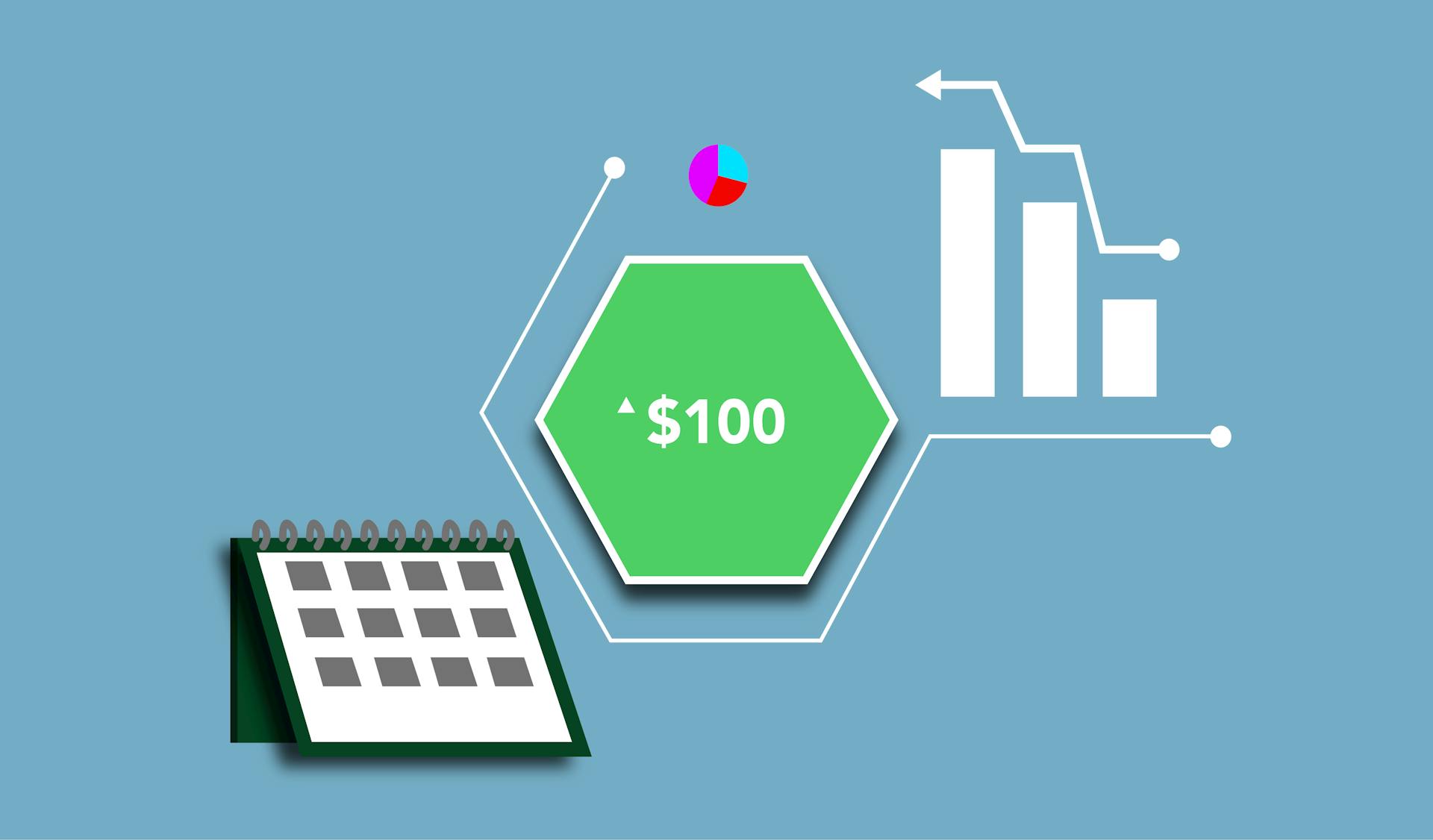
Finding your APR rate on credit cards can be a daunting task, but it's essential to understand how it works and what your options are.
You can find your APR rate on your credit card statement, which is usually mailed to you or available online through your credit card issuer's website or mobile app.
Some credit cards may have a variable APR, which can change over time based on market conditions, while others have a fixed APR, which remains the same throughout the life of the card.
Your credit score can also affect your APR rate, with lower scores often resulting in higher rates.
What Is APR?
APR stands for Annual Percentage Rate, which is the rate at which interest is charged on your credit card balance.
The APR is usually expressed as a yearly rate, but it can vary depending on the credit card issuer and the type of credit card.
APR is calculated based on a simple interest formula, where interest is charged on the outstanding balance.
For example, if your APR is 20%, you'll be charged 20% of your outstanding balance as interest each year.
Finding Your APR

Finding your APR is easier than you think. You can usually find your credit card's primary APR in the app or on the card issuer's website.
Look for it on your monthly statement, it's often located at the top or near the end of the document, in a section explaining how your interest charges get calculated every month. The APR will be expressed as a percentage.
You can also find it in the terms and conditions agreement you receive with your credit card. It's usually in a table called a Schumer box at the top of the page, which is a federally required disclosure of rates and fees.
If you can't find it there, try checking your online account details. They should have the information you need.
There are different types of APRs, including your purchase APR, cash advance APR, and balance transfer APR.
Understanding APR Types
There are several types of APRs, including fixed and variable rates. A fixed APR remains the same over time, while a variable APR can change based on the prime rate.

A variable purchase APR is a fluctuating rate tied to the prime rate, which is set by the Federal Reserve. Your credit card issuer adds a margin to the prime rate to determine your APR.
There are also different types of purchase APRs, each with its own impact on how much interest you may owe on balances carried from one month to the next. These include introductory APRs, which are temporary interest rates offered when you get a new credit card, and standard purchase APRs, which apply to purchases if you don't pay the bill in full by the due date.
Here are some common types of APRs:
- Purchase APR: usually refers to the primary APR for the card, applying to new purchases and existing balances when carried.
- Balance transfer APR: some cards offer a 0% APR period for balances transferred onto the card.
- Cash advance APR: typically very high and starts immediately when using your credit card to get cash.
- Loan rates: some card issuers allow you to use your credit line to take out a loan, with its own APR.
- Payment plan APR: some cards have special features that allow you to identify purchases and make payments over time, with its own APR.
- Penalty APR: if you fail to make the minimum payment on time, the issuer might raise your overall APR substantially.
Types of APR
A variable purchase APR is a fluctuating rate tied to a prime rate, which can change and often does. The prime rate is influenced by the federal funds rate, set by the Federal Open Market Committee.
Your variable APR gets calculated using the prime rate plus an added margin set by your credit card issuer. This means that if the prime rate goes down, your rate could decrease, but if it goes up, your rate might rise.
There are several types of APRs, including purchase APR, balance transfer APR, cash advance APR, loan rates, payment plan APR, and penalty APR. These rates can be disclosed in your credit card's Schumer box.
Here's a breakdown of the different types of APRs:
Some cards have promotional rates that are temporary, lasting a set period, such as the first 12 months of having the card. These rates can be different from the regular purchase APR.
Fixed APR
Fixed APRs are increasingly rare, but they can still be found in some credit card offers.
A fixed APR isn't tied to an index like a prime rate, but it can change over time.
In most cases, credit card companies have to notify customers before changing a fixed rate.
For the first year after a card is issued, the rate can't be changed, unless there are exceptions.
Late payments can trigger a rate increase, even if the APR is fixed.
Introductory APR

Introductory APRs are temporary interest rates offered on new credit cards, lasting only until the promotional period ends.
This promotional period is a great opportunity to pay off your balance before the regular rate kicks in. With no harm to your credit score, you can take advantage of a lower interest rate without worrying about the long-term effects.
At the end of the promotional period, your purchase APR will return to a regular rate and apply to your unpaid credit card balance and future purchases.
APR and Interest
Your credit card's APR is a crucial piece of information, and it's easier to find than you think. You can usually find it in the app, on the card issuer's website, or on your monthly statement.
The APR is a percentage that's expressed in a federally required disclosure called the Schumer box, which is located in the terms and conditions of your card.
You may see other types of APRs, but the primary APR is the one that matters for calculating interest.
To calculate your interest, you can use the Daily Balance method, which involves converting your APR to a daily percentage rate by dividing it by 365. For example, if your APR is 18%, the daily rate is 0.049%.
This daily rate is then multiplied by your current balance to generate the daily interest charge, which gets added to your balance every day until the end of the month.
The interest gets compounded daily, which means it's added to your balance and then earns interest itself. This is why it's essential to pay your balance in full each month to avoid interest fees.
If you're curious about how much interest you'll pay, you can use a credit card interest rate calculator, like the one offered by Discover, to get an estimate.
APR and Credit Card Features
Credit card APRs can be as low as 12.99% or as high as 35.99%. This wide range makes it essential to understand the APR on your credit card.

Some credit cards offer introductory APRs, which can be 0% for 6-21 months, allowing you to save on interest charges during that time.
Credit card features like balance transfer fees, cash advance fees, and foreign transaction fees can add up quickly, so it's crucial to review your credit card agreement carefully.
Penalty APR
A penalty APR can be a real shock to your wallet if you're not careful. It's a higher interest rate that your credit card issuer may charge if you make late payments or exceed your credit limit.
Your credit card agreement should outline your issuer's late payment policy, so be sure to review it carefully.
If you're making minimum payments on time, you'll avoid a penalty APR, which can be as high as 30%.
Your credit card issuer typically bases your APRs on the prime rate and your creditworthiness, so if you're a responsible cardholder, you may not have to worry about a penalty APR.
Paying your monthly payment in full and on time every month can help you avoid interest charges and a penalty APR.
Cash Advance APR
A cash advance APR is usually higher than your regular purchase APR.
Some credit cards let you withdraw cash up to a specified limit, but you'll pay interest on that loan, as well as fees.
The cash advance APR can be higher than the standard purchase APR, and you might also face a flat fee or a percentage of the amount you borrow.
Intro APRs rarely apply to cash advances, so be prepared to pay the higher APR from the start.
You'll need to pay interest on the cash advance, which is different from using your ATM card to withdraw your own money.
Balance Transfer APR
A balance transfer APR is a low introductory interest rate offered by credit cards to encourage you to transfer debt from another card or loan. This can be a smart move if your current card has a high interest rate.
The low intro APR is usually only temporary, so you'll need to pay off the balance transfer as soon as you can to avoid accruing more interest.
APR and Credit Card Options

Your APR can vary depending on your credit score and the type of credit card you have. For example, a credit card with a variable APR can have an APR as high as 30.99%, while a credit card with a fixed APR can have an APR of 12.99%.
To avoid high APRs, consider a credit card with a 0% introductory APR. These cards can offer an APR of 0% for 6-18 months, giving you time to pay off your balance without interest.
A credit limit of $10,000 or more can also help you avoid high APRs, as it provides a larger buffer against interest charges.
However, be aware that credit cards with high credit limits often come with higher APRs, so it's essential to carefully review the terms and conditions before applying.
Some credit cards, such as those from Discover and Capital One, offer APRs as low as 10.99% for people with good credit.
Frequently Asked Questions
How much is 26.99 APR on $3000?
An APR of 26.99% on a $3,000 balance would cost $67.26 in monthly interest charges. This translates to a significant amount of extra interest paid over time.
What is 29.99 APR on a credit card?
29.99 APR on a credit card means you'll owe 0.082% of your balance in interest each day if you don't pay it off in full by the due date
Sources
- https://www.nerdwallet.com/article/credit-cards/what-is-my-credit-card-interest-rate
- https://www.discover.com/credit-cards/card-smarts/what-is-a-purchase-apr/
- https://www.usbank.com/customer-service/knowledge-base/KB0194384.html
- https://www.discover.com/credit-cards/card-smarts/what-is-an-apr/
- https://wallethub.com/answers/cc/how-to-find-interest-rate-on-credit-card-2140692419/
Featured Images: pexels.com


